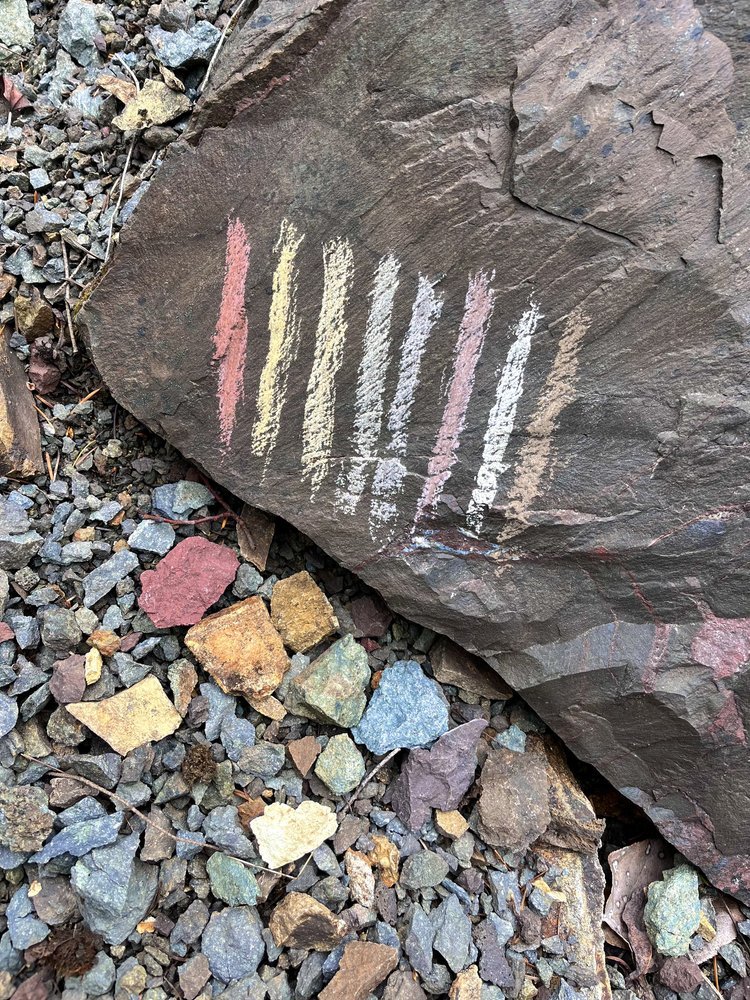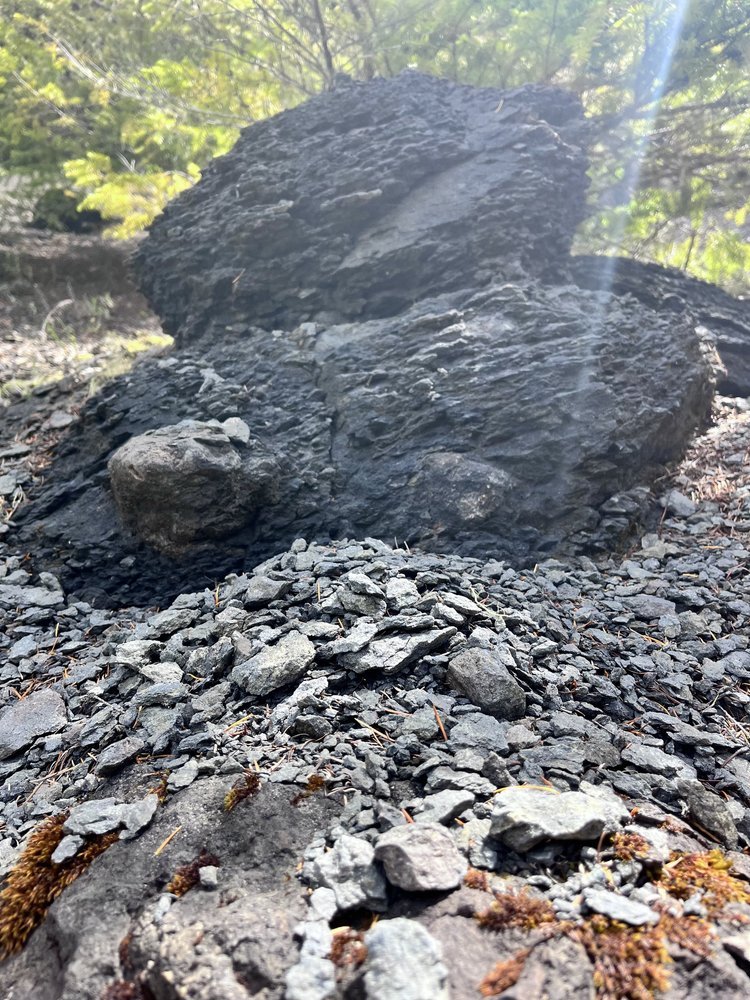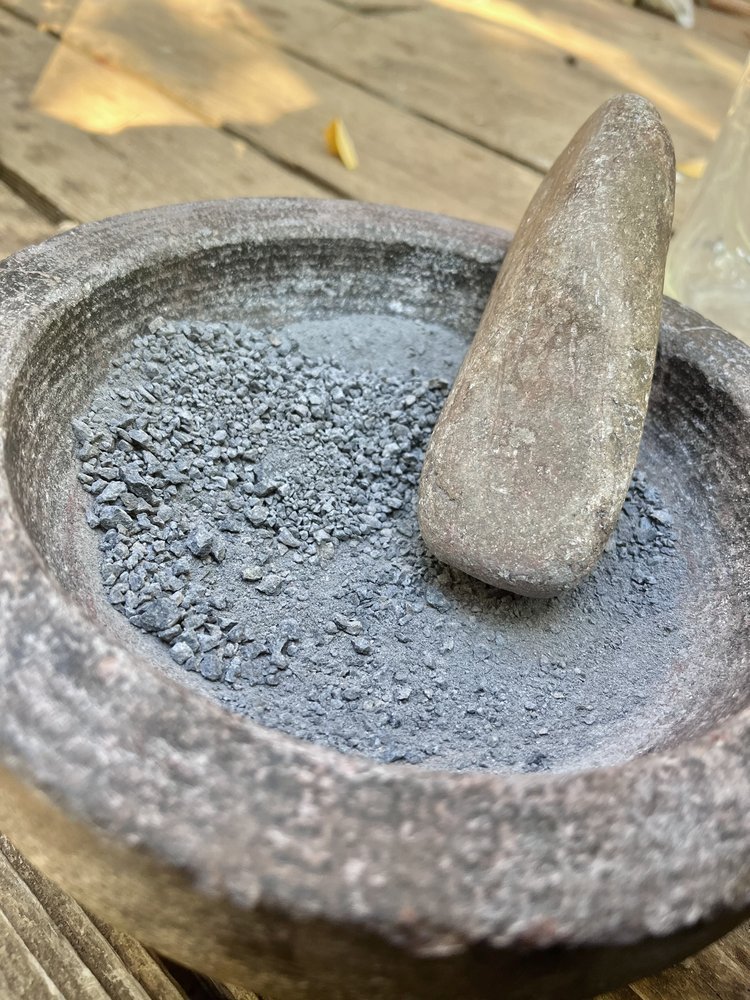pied midden : issue no. 37 : quarry inquiry : hosanna white
Quarry pigments. Photo by Hosanna White.
short for real
I’m keeping my intro short this month, for more than one reason. Skipping the dull ones, I’ll cut to the chase: I’ve been wondering if you, my dear readers, might like a shorter newsletter — at least for a spell. These newsletters have been key for me in forging Wild Pigment Project’s course. For three and a half years, they’ve allowed me the time and space to reflect each month, to question and explore edges. Words have been beacons of light on this path.
Now I want to dance a bit differently: more images, fewer words.
Let’s see how it goes, shall we?
Hosanna getting serious about forest histories. Photo by Hosanna White.
seeing the forest without the trees
November’s Ground Bright pigment, Basalt Blue, was contributed by artist Hosanna White. Hosanna is a painter and wild pigment paint-maker. She’s also a potter who works primarily with wild clays and open pit firing. She lives in a community on land they tend together, as they have for many years — no small feat, when you consider the many hours of consensus meetings about kale beds, cast iron pans, collective vision, and all the details of daily life that that requires.
Hosanna realized recently that she wanted to know more — like, a lot more — about the industrialized forest scapes she’s been criss-crossing over as a forager for years. She’s embarked on a long-term research project to understand what really goes on in these places, and why.
This newsletter features an excerpt from Hosanna’s writings on the subject, along with a collection of historical images and her own photos that she selected to go with her words.
Want to know more about what lies beyond the beauty strips that line the roadways? Let Hosanna take you on a little tour...
Basalt Blue on site. Photo by Hosanna White.
Quarry Inquiry
by Hosanna White
When I first moved to Oregon, I saw the wet, forested mountains through an enchanted lens. It took time for me to see that most of the forests, with the exception of the places set aside for solace in nature, were heavily managed for profit.
The land currently known as Oregon, with its grandiose colonial reputation for westward expansion, has a short, but devastating history entangled in tree cutting and cultivation. The timber industry, through the support and participation of private stakeholders, governmental agencies, and laborers has totally transformed the wonderland of the Pacific Northwest into a “green” commodified nowhereness. It seems to me that anyone looking long and hard enough at a clearcut, regardless of their presumed opinion on the issue, must surely feel the burn of sorrow deep down.
One day, while pigment foraging, I drove into the Cascade Mountains to connect with a gravel quarry near Mount June. Excavators had reached into the mountain side and pulled out rock to make the roads the foresters were then using to reach into the forests and remove the trees. They make these quarries all over the network of forest roads, pulling out gravel as they go. This quarry did not appear remarkable from the road — just an eroding bank of brown soil and stones, surrounded by thousands of acres of US Forest Service managed timber land that has been systematically logged in rotation by private corporations since the beginning of the 1900’s.
Clearcut. Photo by Francis Eartherington.
Climbing up into the quarry, I discovered many nooks and shelves of decorated colorful basalt erosions. It was while sitting here in this abandoned place, with the beauty of the rocks and fog setting in on the horizon, that I felt totally struck by my own ignorance of how the practices of timber management had come to be this way and why we assume we are all powerless to change this extractive landscape. Connecting with this place, I felt a deep need to understand, and so what follows is a brief overview of my research so far — a sort of summary of the paths I’ve started down.
The colonial project of the United States of America began to take hold on the Eastern coast of the continent under a premise of protecting individuals’ property rights. Among other founding philosophical priorities, this was a transplanted concern of European settlers coming from the feudal reach of aristocratic rule. A central bureau organized land distribution, which played a crucial part in westward expansion. From the very beginning, claims to land in the West were sought after by large corporate interests; namely railroads and timber.
Weyerhaeuser, the largest timberland owner in the country today, began its Northwest operations with 900,000 acres in 1905. Today this company alone owns 12+ million acres in the United States and leases 14 million in Canada. Many more private timber companies sprang up across the Northwest in the 1900’s, bringing jobs and wealth into small town economies. This established a powerful link between the timber industry, regional identity, and politics.
American history, since its inception, has been a tale of various monopolies exploiting the resources of the land and capitalizing on cheap or enslaved laborers. Timber is just one story of the commodification of the land, which like oil or cotton, has greatly shaped the country, built its infrastructure, and been, for many, an unquestioned and praised pursuit of the nation. Early logging history on the West Coast is a dynamic story, told thoroughly by Emily K. Brock in her book “Money Trees.” In her research of the period between 1900-1940, Brock highlights the tensions between protecting private ownership and federal regulations. The US Forest Service was founded in 1905, because “the power of these giant corporations in a poor and lightly settled part of the country seemed unimpeded. Federal land managers wished to keep the vast resources of the far west under federal control, even when they stood on private land. They believed regulation and tax structures should control who could access the lumber wealth, as well as when and how.”
Today, the USFS manages 15.6 million acres and the Bureau of Land Management manages 15.7 million acres of public land in Oregon. Most of these public forests are cut in rotation on contract with private logging companies, which is why when you travel into the surrounding foothills throughout the Pacific Northwest, it appears as though there is so little land untouched by the management scheme of “renewable” forestry.
By 1920, the legendary proposition that it would never be possible to cut all the trees in the Pacific Northwest began to be questioned by academics, federal foresters, and industry leaders looking out for their future prospects. The cutting of virgin forests was going to max out eventually and the forestry sector had to seriously consider “timber growing” and “sustainable-yield management.” There was significant resistance, but the new approach began to gain some traction when tax cuts and regulation changes encouraged lumber companies to keep ownership of lands while the cut-over plots were growing back.
In the time since, billions of dollars and hours have been put towards refining the most efficient systems and technologies for replanting, maintaining, and harvesting trees. However, there has always been a tension between the economic perspective and the ecological perspective. Modern logging regulations have steadily incorporated important ecological protections because of scientific pressure and public concern, but not without a fight. Over the decades, countless people have fought for each of these protections, including stream buffers and erosion controls in the 1980’s, habitat protection for certain species in the 1990’s, and arial spray buffers around homes and schools in the 2000’s.
Before and after clearcutting. Photos of a twinned cedar by TJ Watt.
While the Oregon Forest Practice Act, which governs state regulations for private logging, claims that these laws are “adaptable and informed by sound science,” I think it’s fair to question how well they function. After seeing the lifelessness and lack of biodiversity across these tree plantations, I find myself asking, do we really know what impact this scale of logging could have on the health of our forests in generations to come? The environmental protections in place now are of course vital, but are they enough? Emerging awareness of climate change, species extinction, water scarcity, and wildfires have fueled a rise in public concern and a call for greater protections.
More than one good reason to mask up. Photo courtesy of Fairy Creek Blockade.
Industrial forestry has had no choice but to respond to these public sentiments, but their responses amount to little more than the appearance of action or a manipulation of public image. I saw this best illustrated when leaving the Eugene airport once. A corporate mill that sat across the intersection with a big billboard read, “more trees planted today than 100 years ago.” While this is true and meant to be relieving to my ecological dread, it isn’t. I have spent enough time in the back hills, on forest roads, walking through clear cuts and bush whacking through tree farms to know that what has been taken is not what is replaced.
This is especially true for old growth. Only about 10% of Oregon’s old growth forests remain and an estimated 4 to 7% remain nationally. According to Oregon Forest Resources Institute, a PR company for the industry says, “logging of old-growth forests virtually never occurs in Oregon.” However, the Climate Forests Campaign has read the fine print and has documented several current old growth inclusive logging projects across the country, with at least 9 in Oregon.
This isn’t just about old growth, even though old growth is certainly important, especially as a climate change mitigation strategy. For me, this is about all the forests, the quarries, the extraction, the capitalism, the planet-killing mentality that is constantly choosing human luxury and globalized aesthetics over ecological integrity, belonging and reciprocity, as well as our future as a species. The impact adds up. I so badly want to be with these places in a healing way, in community doing repair, taking an honest assessment of damage done and the debts to repay. I want to grieve with these landscapes and sit in working groups with fellow citizens to find other solutions to the need for local jobs and revenue for the state. With everything that we know now, how can our current trajectory still be the unquestioned course?
Basalt Blue in the mortar. Photo by Hosanna White.
What inspires me at the vista of this wide winding landscape of history, legal jargon and politics, are three things. And no, voting is not one of them — but elections are, I think, an important beginning.
First, Oregon needs to have transparent campaign financing. It is one of only 5 states in the country that does not have honest, capped funding, which means at the end of the day, timber money is putting a lot of pressure on our local representatives. Honest Elections is a grass roots organization that tried to get an initiative on the ballot this year but was blocked from even beginning the signature gathering period. This initiative would go a very long way for more issues than one and deserves our attention.
Secondly, a seemingly small, but foundational case in Washington state gives me reason to hope. A coalition of conservation organizations has successfully put forth a case to overturn the historic assumption that generating revenue from the forests is the only priority when managing the land “in the best interest of all the people.” Managing public lands for economic returns has been a cemented assumption of the 20th century. The defendants of this case want the “values derived from our forests, such as clean water, tribal treaty rights, outdoor recreation, fire resiliency, carbon sequestration to mitigate climate change, habitat for threatened and endangered species” to be considered equally as important when managing for the best interests of all people.
Thirdly, I am inspired to see more land conservation and restoration projects beginning to approach the work of decolonization in their organizational culture and priorities, including leveraging assets for funding indigenous consultations for land restoration and restorative fire projects.
Basalt blue, a stone pigment I gathered in a mountain quarry, sparked me to dig into this research project. It holds layers of these histories of forest extraction. Through its exposure, and now, slow erosion, my hope is for the beauty of this earth from this wounded place to awaken us from our complacency towards industrial extraction, whatever it may be in each of our bio regions and find to ways, even the smallest acts, to care for these places again.
~ Hosanna White, November 2022
Ball of Basalt Blue made by Hosanna. Photo by Hosanna White.
wpp news
Great news! Due to its resounding popularity, the Wild Pigment Project Group Exhibition at form & concept gallery has been extended through December 23rd. If you’re passing through Santa Fe, be sure to check it out in person.
AND you can check out the ENTIRE exhibition (including my solo show Records of Being Held) in this fantastic online EXHIBITION GUIDE, which includes artists’s statements, bios, and director and curator intros.
pigments from the waste stream for your friends
I’m very excited about the December Ground Bright pigment. TANOMA OCHRE is a rich red ochre, contributed by artist/herbalist Dana O’Driscoll, that’s made up of iron oxides that have leached into Pennsylvanian waterways from abandoned mines. The oxides have been reclaimed through the use of drainage ponds by Evergreen Conservancy, which will be the recipient of this month’s 22% donation.
There are two hues — a rich sienna and a warm deep orange — and from now ’til December 12th at 8 am PST, new subscribers can have a free gift packet sent to a friend or relative of their choice in addition to the one going to their own mailbox. Packets include the pigment, a description of its origins, and directions for a special activity involving the pigment (Dana is giving us a great one!).
Thanks for reading, and do let me know if you’ll welcome a new, more time-gentle newsletter.
Stay With Me,
<3 Tilke
Tanoma Ochre, December’s Ground Bright pigment. Photo by me, Tilke Elkins











